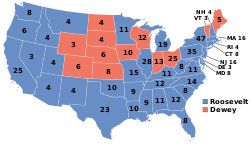| | ||||||||||||||||||||||||||
November 7, 1944 [1] | ||||||||||||||||||||||||||
All 9 Mississippi votes to the Electoral College | ||||||||||||||||||||||||||
|---|---|---|---|---|---|---|---|---|---|---|---|---|---|---|---|---|---|---|---|---|---|---|---|---|---|---|
| ||||||||||||||||||||||||||
 County Results Roosevelt 60–70% 70–80% 80–90% 90–100% | ||||||||||||||||||||||||||
| ||||||||||||||||||||||||||
The 1944 United States presidential election in Mississippi took place on November 7,1944,as part of the 1944 United States presidential election. Mississippi voters chose nine [2] representatives,or electors,to the Electoral College,who voted for president and vice president.
Contents
Ever since the end of Reconstruction,Mississippi had been a one-party state dominated by the Democratic Party. The Republican Party was virtually nonexistent as a result of disenfranchisement among African Americans and poor whites, [3] including voter intimidation against those who refused to vote Democratic.
From the time of Henry A. Wallace's appointment as vice-president and the 1943 Detroit race riots, [4] however,the northern left wing of the Democratic Party became committed to restoring black political rights, [5] a policy vehemently opposed by all Southern Democrats as an infringement upon "states' rights". Anger with the FDR administration intensified further when the Supreme Court ruled in Smith v. Allwright that the white primaries upon which the politics of Mississippi and most other Southern states [a] were based violated the Fourteenth and Fifteenth Amendments.
Consequently,Mississippi Democrats,already developing opposition to the New Deal,which had provided substantial work for white Mississippians during the 1930s,were very concerned about Roosevelt being renominated for a fourth term. In fact,the original slate of Democratic electors was pledged to vote for a candidate other than Roosevelt. [6] However,FDR remained extremely popular with the majority of Mississippians,even those wealthy enough to pay the state's poll tax. [7] Consequently,Governor Thomas L. Bailey was forced to call the state legislature,which replaced the convention-nominated Democratic electors with electors pledged to vote for FDR. [7] 4 electors nominated by the state Democratic convention pledged themselves to vote for FDR and were included on the Democratic ticket. On the other hand,5 electors nominated by the state Democratic convention chose to not pledge themselves to FDR and were put on a separate ticket altogether. [8]
Mississippi was won by incumbent President Franklin D. Roosevelt (D–New York),running with Senator Harry S. Truman,with 88.02 percent of the popular vote,against Governor Thomas E. Dewey (R–New York),running with Governor John Bricker,with 6.44 percent of the popular vote,making it Roosevelt's strongest state in the election. [9] [10]
As of 2024,this marks the last time that Forrest County has voted for a Democratic presidential candidate. [11] It was also the last time until 1972 that Mississippi would back the national winner in a presidential election. This was the last election in which every county voted for the Democrats in Mississippi. The next election would also see all the state's counties go to just one party,albeit to the Dixiecrats rather than the Democrats. [b] The same would be true of 1964,when all the state's counties went entirely to the Republican Party.
As Roosevelt's strongest state,this is the most recent time Mississippi has voted more Democratic than Georgia.


